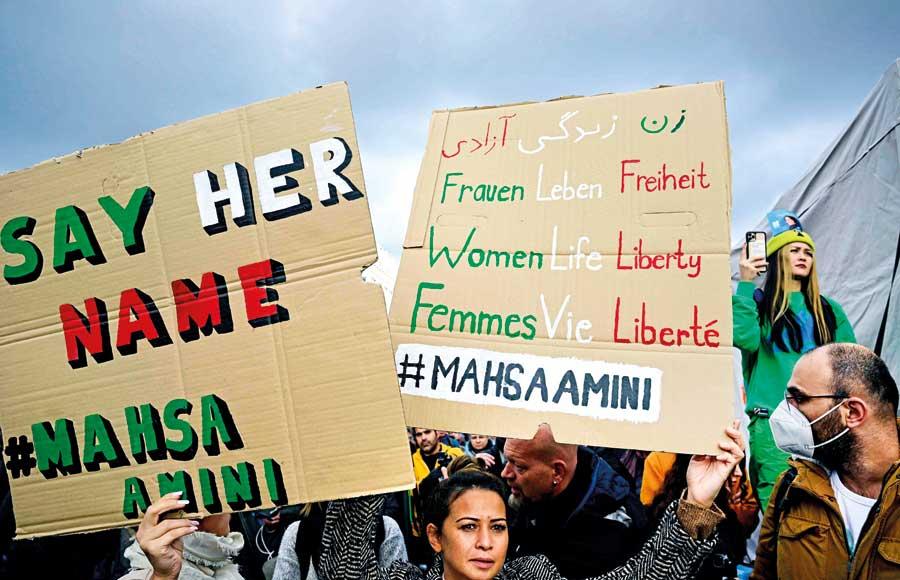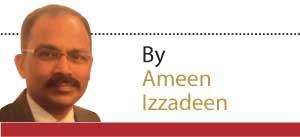Reply To:
Name - Reply Comment

A woman holds two placards, one reading “Say her name Mahsa Amini” (L) and the other “Women Life Liberty” in several languages, during a protest in support of the Iranian protesters, on September 28, 2022 near Berlin’s landmark Brandenburg Gate, following the death of a woman in morality police custody in Iran. AFP
The controversy over a piece of Muslim women’s clothing is once again making international headlines. This time following the death of a young woman in Iran after her arrest by the country’s morality police.
country’s morality police.
Mahsa Amini, a 22-year-old Kurdish woman was arrested in Tehran on September 13 by Iran’s morality police for allegedly violating the country’s hijab law which requires women to cover their hair with a headscarf. Such arrests are not unusual in Iran. Those who are arrested for flouting the law are detained and ‘rehabilitated’. But Mahsa’s case was different because she was the first woman to die after being arrested for violating the hijab law. The allegation that she died due to assault while in police custody is denied by the Iranian government.
Since then, protests have erupted in Iran’s urban centres and about 76 people have been killed in clashes with security forces.
Adding more meat to the controversy, CNN’s star reporter Christianne Amanpour who has donned the hijab in the past to report from Iran, her country of origin, refused to abide by the condition that she wore the hijab for an interview with Iran’s President Ebrahim Raisi in New York during the United Nations annual General Assembly sessions. The coveted interview – the first by the new Iranian president to a foreign media outlet -- was cancelled. Amanpour said she did not want to comply with the demand because “there is no law in the United States that requires a journalist to wear a scarf for any interview.”
It may not be appropriate for men to decide on what women should wear or not wear. After all, it is up to the women to decide what parts of the body they should cover or expose. But just like all freedoms, the freedom to cover or uncover should be exercised with responsibility, lest it causes chaos. This is why public nudity or what is subjectively called indecent exposure is a crime in many countries. Public indecency generally refers to acts involving nudity or sexual activity in view of the public, often with the intent to shock, offend, or arouse.
The US Supreme Court has affirmed the right of states to outlaw public nudity, holding that the state has an interest in “protecting societal order and morality,” and that public nudity is not “free expression” protected by the First Amendment.
The interpretation of what is referred to as public nudity, morality and modesty varies from culture to culture. The threshold of modesty or morality is set higher in non-Western cultures and religions than in Western nations which show a tendency to adopt cultural liberalism while abandoning Christian morality. Cultural or social liberals believe that society should not impose any specific code of behaviour and they see themselves as defending the moral rights of nonconformists to express their own identity however they see fit as long as they do not harm anyone else.
In Muslim majority nations, social norms are formed taking into consideration the harm a particular action may cause not only to an individual but also to the community at large. When there is a conflict between community rights and individual rights, priority is often given to community rights in terms of the Shariah law. This explains why some Muslim nations have enacted public dress code laws and say such laws are necessary to prevent social disintegration.
When some journalists asked Yemeni Nobel peace laureate Kamran Tawakkal about her hijab and how it did not go with her level of intellect and education, she is reported to have replied, “Man in the early times was almost naked, and as his intellect evolved he started wearing clothes. What I am today and what I’m wearing represents the highest level of thought and civilization that man has achieved and is not regressive. It’s the removal of clothes again that is regressive back to ancient times.”
The hijab or the headscarf precedes the Prophet Muhammad’s mission in Arabia. The Quranic verses that exhort modesty first urge the men to lower their gaze and then go on to advise women to lower their gaze, guard their modesty; not to display their beauty and ornaments except what (must ordinarily) appear thereof; that they should draw their veils over their bosoms and not display their beauty except to mahram male relatives. Mahram is a member of a family with whom marriage is forbidden – e.g.: father, brother, son and nephew.
The Quran also says “…Oh, prophet, tell your wives, your daughters and the women of the believers to draw their cloaks (veils) all over their bodies. That will be better, that they should be known (as free respectable women) so as not to be annoyed (molested or insulted)...”
Muslim scholars often point to Mother Mary’s head covering, and say that both the Old Testament and New Testament support the hijab. They refer to 1 Corinthians 11:5, Geneses 24: 64-65 and several Christian and Jewish traditions to support the veil.
In the spectrum of modesty, if at the left extreme is nudity, the right extreme is a fully covered head-to-toe dress like Afghanistan’s Burqa which the women wear either through choice or under compulsion. As cultures progress or regress, the spectrum’s equilibrium point shifts accordingly.
In some Muslim communities, even revealing male dress is frowned upon, for such exposure could arouse the opposite sex and also homosexually inclined people. So in conservative Muslim nations like Iran, the spectrum’s equilibrium point shows a tendency toward the right. In countries where cultural or social liberalism is encouraged, the equilibrium point shows a propensity for a leftward movement. Even some Muslim countries in the Gulf region, North Africa and Central Asia, under the influence of the West, are moving in this leftward direction.
The hijab Muslim women wear by choice or under compulsion from a male relative or peer pressure remains a contentious symbol worldwide. However, the human rights violation caused by hijab bans imposed by some countries such as France, the Netherlands, Belgium, Germany and China on Muslim minorities does not get the level of media exposure that the Mahsa Amini case or any controversy arising out of a hijab law gets.
If the right to ditch the hijab is upheld as a fundamental right, the right to wear it also should be upheld. However, over the past two decades, in petitions against the hijab ban, the European Court of Human Rights has ruled in favour of states. The latest ruling was in July last year. The court ruled that companies could ban their female Muslim employees from wearing a headscarf under certain conditions. Muslims in Europe have criticised the ruling pointing to institutionalized discrimination against Muslim minorities and the double standards in the approach to human rights.
The Iranian protesters who burn their hijabs remind us of those Algerian women who in public support for -- or surrender to -- the French colonisers’s cultural war effort, burnt their hijabs at a public square in the capital. It is said some of these women were compelled to do so to save their male relatives from the French death squad.
Though in the liberal West, the hijab is seen as a symbol of oppression, some Muslim women say that by wearing the hijab they make a powerful statement to underline its importance not only as a symbol of piety but also as a way of resisting the West’s cultural colonialism.